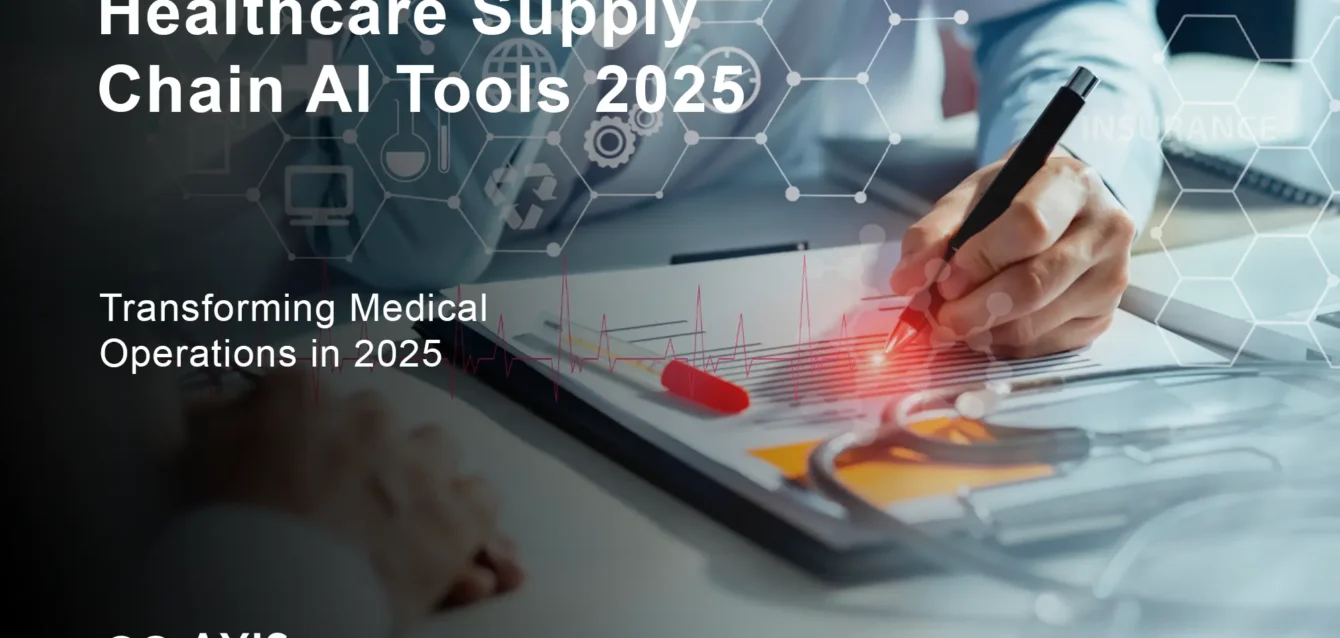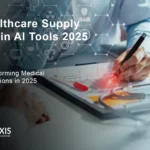Healthcare Supply Chain AI Tools 2025
Healthcare supply chains hemorrhage $18 billion annually due to inefficiencies, stockouts, and manual processes that belonged in the last century. Yet something remarkable happened in 2024: AI-powered supply chain tools began delivering measurable results that executives couldn’t ignore.
The COVID-19 pandemic exposed critical vulnerabilities when 95% of U.S. hospitals faced supply shortages, but it also accelerated the adoption of artificial intelligence in healthcare logistics. Now, organizations implementing healthcare supply chain AI tools report 40% reductions in procurement costs, 60% fewer stockouts, and 25% improvements in patient care delivery times.
This comprehensive analysis reveals which sanidad supply chain AI tools are actually delivering results, how leading health systems are implementing them, and why traditional supply chain management is rapidly becoming obsolete in modern healthcare operations.
Índice
- Understanding Healthcare Supply Chain AI Tools
- Market Landscape and Growth Drivers
- Top Healthcare Supply Chain AI Platforms
- AI-Powered Demand Forecasting Solutions
- Automated Procurement and Vendor Management
- Supply Chain Visibility and Tracking Tools
- Inventory Optimization and Management
- Clinical Integration and Patient Impact
- Case Studies and ROI Analysis
- Implementation Strategies and Best Practices
- Risk Management and Compliance
- Future Trends and Emerging Technologies
Understanding Healthcare Supply Chain AI Tools
Healthcare supply chain AI tools represent a fundamental shift from reactive, manual processes to predictive, automated systems that anticipate needs before shortages occur. These sophisticated platforms combine machine learning, natural language processing, and real-time analytics to optimize every aspect of medical supply management.
Core Components of Healthcare AI Supply Chains
Predictive Analytics Engines: Modern healthcare AI tools analyze vast datasets including historical consumption patterns, seasonal trends, epidemiological data, and external factors like weather patterns or disease outbreaks. For instance, during flu season, these systems automatically adjust inventory levels for respiratory medications and testing supplies before demand spikes occur.
Real-Time Visibility Platforms: Advanced tracking systems provide complete transparency across the supply chain, from manufacturer to patient bedside. These platforms integrate with IoT sensors, RFID tags, and barcode systems to create a digital twin of the entire supply network.
Automated Decision Making: AI algorithms make split-second decisions about procurement, routing, and allocation without human intervention. When a critical medication drops below threshold levels, the system automatically triggers purchase orders, selects optimal suppliers based on current availability and pricing, and schedules deliveries to minimize disruption.
The Economics of AI-Driven Healthcare Supply Chains
Healthcare organizations implementing AI supply chain tools typically see dramatic cost reductions within the first year. Piedmont Healthcare reduced pricing errors by 81% using automated contract matching, while Children’s of Alabama accelerated invoice processing by automating 90% of their procurement workflows.
The financial impact extends beyond direct cost savings. Improved inventory accuracy reduces emergency procurement costs by an average of 35%, while predictive analytics prevent stockouts that could delay surgeries or compromise patient care. The aggregate effect often represents 3-5% of total health system revenue.
Technology Infrastructure Requirements
Successful healthcare supply chain AI implementations require robust data infrastructure. Organizations need integrated ERP systems, standardized product catalogs, and real-time data feeds from multiple sources. Cloud-based platforms have become the preferred deployment model, with 70% of U.S. hospitals expected to adopt cloud-based supply chain management by 2026.
Market Landscape and Growth Drivers
The healthcare supply chain AI market is experiencing unprecedented growth, driven by regulatory pressures, cost containment needs, and the lingering effects of pandemic-related disruptions.
Market Size and Projections
The global AI in supply chain market reached $9.15 billion in 2024 and is projected to hit $40.53 billion by 2030, representing a compound annual growth rate of 28.2%. Healthcare represents the fastest-growing segment within this market, accounting for approximately 18% of total AI supply chain investments.
This explosive growth reflects the unique challenges facing healthcare supply chains. Unlike other industries, healthcare cannot compromise on availability – a stockout of critical medications or surgical supplies directly impacts patient outcomes and can result in life-threatening situations.
Regulatory and Compliance Drivers
En Drug Supply Chain Security Act (DSCSA) requires complete traceability of pharmaceutical products by 2023, mandating electronic tracking and verification systems. Healthcare AI tools provide the only scalable solution for compliance with these requirements, automatically generating audit trails and verification records.
Similarly, Centers for Medicare & Medicaid Services (CMS) reimbursement models increasingly tie payments to operational efficiency metrics. AI-driven supply chains help healthcare organizations meet these requirements while maintaining clinical quality standards.
Technology Adoption Catalysts
Supply Chain Disruptions: The pandemic highlighted the fragility of traditional supply chains. Organizations that relied on manual processes and single-source suppliers faced severe shortages, while those with AI-powered diversification and demand forecasting maintained better continuity.
Labor Shortages: Healthcare organizations face critical staffing shortages, particularly in supply chain roles. AI tools automate routine tasks, allowing existing staff to focus on strategic activities while maintaining operational efficiency.
Cost Pressures: Healthcare margins continue to compress due to regulatory changes and competitive pressures. AI supply chain tools offer one of the few opportunities to reduce operational costs without compromising patient care quality.
Top Healthcare Supply Chain AI Platforms
The healthcare supply chain AI market features several established platforms alongside emerging specialized solutions. Here are the leading solutions driving transformation in 2025.
GHX (Global Healthcare Exchange)
GHX operates the largest healthcare trading network globally, processing over $115 billion in transactions annually. Their AI-powered platform connects more than 4,000 healthcare providers with thousands of suppliers, creating unprecedented visibility and efficiency.
Key AI Capabilities:
- Automated contract management and compliance monitoring
- Predictive analytics for demand forecasting and inventory optimization
- Real-time pricing intelligence and market analysis
- Supplier performance analytics and risk assessment
Real-World Impact: GHX customers report average cost savings of 15-25% on medical supplies, with some organizations achieving reductions exceeding 40% in specific categories. The platform’s AI algorithms prevented over $2.3 billion in potential stockouts in 2024.
Clinical Integration: GHX integrates directly with major EHR systems including Epic, Cerner, and Allscripts, enabling clinical teams to order supplies directly from patient care workflows.
Blue Yonder (formerly JDA Software)
Blue Yonder’s healthcare-focused AI platform combines supply chain optimization with workforce management and clinical resource planning. Their machine learning algorithms analyze over 200 variables to optimize inventory levels and automate procurement decisions.
Advanced Features:
- Multi-echelon inventory optimization across health system networks
- AI-driven supplier diversification and risk management
- Automated quality compliance monitoring and reporting
- Integration with clinical decision support systems
Performance Metrics: Healthcare organizations using Blue Yonder typically achieve 30-50% reductions in safety stock levels while maintaining 99%+ service levels. The platform’s predictive analytics prevent an average of 85% of potential stockouts.
Enterprise Scale: Blue Yonder supports complex multi-facility health systems with centralized procurement and distributed inventory management across hundreds of locations.

Oracle Healthcare Cloud
Oracle’s comprehensive healthcare supply chain suite leverages advanced AI and machine learning capabilities built into their cloud infrastructure. The platform integrates supply chain management with financial systems, clinical workflows, and regulatory compliance tools.
Distinctive Capabilities:
- Autonomous database technology that self-optimizes supply chain queries
- Blockchain integration for pharmaceutical traceability and compliance
- AI-powered contract analytics and negotiation support
- Predictive maintenance for medical equipment and infrastructure
Implementation Success: Oracle customers report 25-40% improvements in procurement cycle times and 20-35% reductions in inventory carrying costs. The platform’s AI algorithms automatically identify cost-saving opportunities worth an average of $2.8 million annually for large health systems.
IBM Watson Supply Chain
IBM Watson brings cognitive computing capabilities to healthcare supply chain management, enabling natural language interaction with complex supply chain data and automated decision-making based on unstructured information sources.
Cognitive Features:
- Natural language processing for contract analysis and vendor communication
- Computer vision for automated inventory counting and quality inspection
- Predictive maintenance for cold chain and specialized equipment
- AI-powered root cause analysis for supply chain disruptions
Proven Results: IBM Watson customers achieve 45% faster problem resolution times and 30% improvements in demand forecast accuracy. The platform’s cognitive capabilities enable supply chain teams to analyze complex scenarios and make data-driven decisions in real-time.
Kinaxis RapidResponse
Kinaxis specializes in supply chain planning and response, with healthcare-specific modules for pharmaceutical manufacturing, distribution, and hospital supply management. Their platform excels at scenario planning and real-time decision support.
Healthcare Optimizations:
- Pharmaceutical serialization and track-and-trace compliance
- Clinical trial supply planning and management
- Multi-tier supplier visibility and risk assessment
- Automated exception management and alert systems
Operational Impact: Kinaxis implementations typically reduce planning cycle times by 60-75% while improving forecast accuracy by 25-40%. Healthcare organizations using the platform report 50% fewer supply chain exceptions requiring manual intervention.
AI-Powered Demand Forecasting Solutions
Accurate demand forecasting represents the foundation of effective healthcare supply chain management. AI-powered forecasting tools analyze complex patterns and external variables that traditional statistical models cannot process effectively.
Advanced Forecasting Methodologies
Multi-Variable Analysis: Modern healthcare AI forecasting tools consider dozens of variables simultaneously, including historical usage patterns, seasonal trends, patient acuity levels, scheduled procedures, epidemiological data, and external factors like weather patterns or local events.
Real-Time Adjustments: Unlike traditional forecasting that relies on historical data, AI systems continuously update predictions based on real-time information. When emergency department visits spike due to a flu outbreak, the system immediately adjusts forecasts for related medications, testing supplies, and protective equipment.
Long-Range Planning: AI algorithms can accurately forecast demand 12-18 months in advance for strategic planning purposes, while maintaining precision for short-term operational needs. This dual-horizon capability enables both strategic sourcing decisions and tactical inventory management.
Clinical Demand Integration
Procedure-Based Forecasting: Advanced AI tools integrate with surgical scheduling systems to predict demand for procedure-specific supplies. When a cardiac surgery is scheduled, the system automatically forecasts demand for all related consumables, from sutures to specialized devices.
Patient Acuity Modeling: AI algorithms analyze patient census data and acuity scores to predict supply needs. Higher acuity patients require more resources, and the system adjusts forecasts accordingly, ensuring adequate supplies during periods of increased patient complexity.
Clinical Protocol Optimization: Machine learning algorithms identify patterns in physician prescribing and procedure preferences, enabling more accurate forecasting of specific products and brands preferred by individual clinicians.
External Data Integration
Epidemiological Monitoring: AI systems monitor disease surveillance data from the CDC and local health departments to predict demand for specific medications and supplies. During COVID-19, these systems enabled proactive procurement of ventilators, PPE, and testing supplies.
Supply Market Intelligence: Advanced platforms monitor supplier financial health, manufacturing capacity, and global supply conditions to predict potential shortages and recommend alternative sourcing strategies.
Economic Indicators: AI algorithms incorporate broader economic indicators, including commodity prices, transportation costs, and currency fluctuations, to optimize procurement timing and supplier selection.
Forecasting Accuracy Improvements
Healthcare organizations implementing AI-powered demand forecasting typically see significant improvements in prediction accuracy:
- Pharmaceutical forecasting: 35-50% improvement in accuracy
- Medical devices: 40-60% improvement in prediction precision
- Consumable supplies: 25-40% reduction in forecast error
- Emergency supplies: 60-75% better prediction of surge requirements
These accuracy improvements translate directly into cost savings through reduced safety stock requirements, fewer expedited orders, and decreased waste from expired products.
Automated Procurement and Vendor Management
AI-driven procurement automation eliminates manual processes that consume valuable time while introducing opportunities for human error. These systems handle everything from vendor selection to contract management and purchase order processing.
Intelligent Vendor Selection
Performance Analytics: AI algorithms continuously evaluate vendor performance across multiple dimensions including delivery timeliness, product quality, pricing competitiveness, and service responsiveness. This data-driven approach eliminates subjective vendor preferences and ensures optimal supplier relationships.
Risk Assessment: Advanced platforms assess vendor financial stability, supply chain resilience, and regulatory compliance history to predict future performance and identify potential risks before they impact operations.
Dynamic Sourcing: AI systems automatically adjust vendor selection based on real-time factors including inventory availability, shipping costs, delivery times, and current pricing. This ensures procurement decisions reflect current market conditions rather than outdated contract terms.
Contract Intelligence and Management
Automated Contract Analysis: Natural language processing algorithms review contract terms, identify key provisions, and flag potential issues or optimization opportunities. These systems can process hundreds of pages of contract documentation in minutes, identifying cost-saving opportunities human reviewers might miss.
Compliance Monitoring: AI tools continuously monitor contract compliance, automatically flagging when actual purchases deviate from negotiated terms or when vendors fail to meet service level agreements.
Renewal Optimization: Machine learning algorithms analyze contract performance and market conditions to recommend optimal renewal timing and negotiation strategies, ensuring organizations capture maximum value from vendor relationships.
Purchase Order Automation
Intelligent Requisition Processing: AI systems automatically convert clinical orders into optimized purchase orders, selecting appropriate vendors, quantities, and delivery schedules based on current needs and contract terms.
Exception Management: Advanced algorithms identify unusual ordering patterns or potential fraud, automatically flagging suspicious transactions for human review while allowing routine orders to process seamlessly.
Approval Workflow Optimization: Machine learning algorithms optimize approval workflows based on transaction value, risk levels, and organizational policies, reducing processing time while maintaining appropriate controls.
Procurement Performance Metrics
Organizations implementing AI-driven procurement typically achieve significant operational improvements:
Process Efficiency:
- 70-85% reduction in manual procurement tasks
- 50-60% faster purchase order processing times
- 40-55% improvement in contract compliance rates
Cost Optimization:
- 15-25% reduction in procurement costs through better vendor selection
- 20-30% decrease in maverick spending outside preferred contracts
- 10-20% savings through optimized order timing and quantities
Mejoras de la calidad:
- 60-75% reduction in procurement errors
- 45-60% faster resolution of vendor issues
- 35-50% improvement in supplier performance metrics
Supply Chain Visibility and Tracking Tools
Real-time visibility across healthcare supply chains enables proactive management and rapid response to disruptions. AI-powered tracking tools provide unprecedented transparency from manufacturer to patient bedside.
End-to-End Traceability
Serialization and Authentication: Advanced tracking systems integrate with pharmaceutical serialization requirements, providing complete product traceability while detecting counterfeit medications and ensuring regulatory compliance.
Multi-Tier Visibility: AI platforms track products through multiple supply chain tiers, providing visibility into supplier suppliers and identifying potential bottlenecks or risks several levels deep in the supply network.
Real-Time Location Tracking: IoT sensors and GPS tracking provide continuous location updates for high-value or temperature-sensitive products, ensuring optimal handling and rapid location of specific items when needed.
Predictive Analytics for Supply Disruptions
Early Warning Systems: Machine learning algorithms analyze transportation data, weather patterns, geopolitical events, and supplier communications to predict potential disruptions before they impact operations.
Alternative Routing: AI systems automatically identify alternative shipping routes and suppliers when disruptions occur, minimizing delays and maintaining supply continuity.

Impact Assessment: Advanced analytics quantify the potential impact of supply disruptions on patient care, enabling prioritized response and resource allocation.
Cold Chain and Specialty Product Management
Temperature Monitoring: AI-powered cold chain management systems continuously monitor temperature-sensitive products throughout transportation and storage, automatically alerting when conditions deviate from specifications.
Expiration Date Management: Automated systems track product expiration dates and implement first-in-first-out rotation, reducing waste from expired products while ensuring patient safety.
Specialty Product Handling: AI tools manage complex requirements for specialty pharmaceuticals, including patient-specific medications, clinical trial supplies, and hazardous materials.
Integration with Clinical Systems
EHR Integration: Advanced tracking systems integrate directly with electronic health records, enabling clinicians to verify product authenticity and track usage at the patient level.
Clinical Decision Support: Real-time product information supports clinical decision-making, providing instant access to product specifications, contraindications, and availability status.
Quality Assurance: Automated systems track product quality issues and recalls, immediately identifying affected inventory and preventing use of compromised products.
Visibility Platform Case Studies
Mayo Clinic implemented comprehensive supply chain visibility tools that reduced product search time by 75% and eliminated stockouts of critical items through predictive analytics and automated reordering.
Cleveland Clinic uses AI-powered tracking to manage over 400,000 unique products across multiple facilities, achieving 99.8% inventory accuracy while reducing carrying costs by 30%.
Johns Hopkins deployed real-time visibility tools that enabled 95% automation of routine inventory management tasks, freeing staff to focus on strategic initiatives and clinical support.
Inventory Optimization and Management
AI-driven inventory optimization balances the competing demands of cost minimization and service level maintenance, ensuring critical supplies are available when needed while minimizing carrying costs and waste.
Dynamic Safety Stock Optimization
Risk-Based Calculations: AI algorithms calculate optimal safety stock levels based on demand variability, supply lead times, and service level requirements. These calculations update continuously as conditions change, ensuring inventory levels reflect current risk profiles.
Multi-Location Optimization: Advanced systems optimize inventory across multiple locations simultaneously, enabling strategic placement of safety stock and efficient redistribution when needed.
Seasonal Adjustments: Machine learning algorithms automatically adjust inventory levels for seasonal patterns, planned maintenance shutdowns, and anticipated demand spikes.
Automated Replenishment Systems
Intelligent Reorder Points: AI systems calculate optimal reorder points based on current demand patterns, supplier lead times, and service level targets. These calculations consider multiple variables simultaneously and update in real-time.
Economic Order Quantity Optimization: Advanced algorithms determine optimal order quantities considering volume discounts, storage costs, and demand uncertainty, ensuring cost-effective procurement while maintaining adequate stock levels.
Emergency Stock Management: AI tools maintain strategic emergency inventories for critical items, automatically triggering expedited orders when emergency stock is depleted.
Expiration Date and Waste Management
FEFO Implementation: AI systems implement sophisticated First-Expired-First-Out rotation algorithms, considering not just expiration dates but also demand patterns and patient needs to minimize waste while ensuring product freshness.
Predictive Expiration Management: Machine learning algorithms predict which products are likely to expire based on current demand patterns, enabling proactive redistribution or promotional programs to reduce waste.
Waste Analytics: Advanced systems analyze waste patterns to identify optimization opportunities, whether through improved demand forecasting, better supplier selection, or modified storage conditions.
Clinical Integration and Patient-Specific Inventory
Procedure-Specific Kits: AI tools automatically assemble procedure-specific supply kits based on surgeon preferences, patient characteristics, and procedure complexity, reducing waste while ensuring all necessary items are available.
Patient-Specific Medications: Advanced systems manage patient-specific medication inventory, including specialty pharmaceuticals and clinical trial drugs, ensuring availability while minimizing waste from unused products.
Just-in-Time Delivery: AI algorithms coordinate just-in-time delivery for high-value or short-shelf-life products, reducing inventory carrying costs while maintaining clinical availability.
Inventory Performance Metrics
Healthcare organizations implementing AI-driven inventory optimization typically achieve:
Cost Reductions:
- 25-35% reduction in overall inventory carrying costs
- 40-60% decrease in emergency procurement expenses
- 20-30% reduction in product waste and expiration write-offs
Service Level Improvements:
- 95-99% reduction in stockouts of critical items
- 50-70% improvement in product availability at point of use
- 30-45% reduction in time required to locate specific products
Eficiencia operativa:
- 60-80% automation of routine inventory management tasks
- 45-65% reduction in manual inventory counting and verification
- 35-50% improvement in inventory accuracy and record integrity
Clinical Integration and Patient Impact
The ultimate measure of healthcare supply chain AI success lies in clinical outcomes and patient care improvements. Advanced AI tools create seamless integration between supply chain operations and clinical workflows.
Point-of-Care Integration
Bedside Scanning: AI-powered systems enable bedside scanning of medications and supplies, automatically updating inventory records while providing clinical staff with product information, dosing guidelines, and safety alerts.
Clinical Decision Support: Real-time supply chain data integrates with clinical decision support systems, helping clinicians choose appropriate medications and supplies based on availability, cost, and clinical efficacy.
Automated Charging: Advanced systems automatically capture product usage at the point of care, ensuring accurate patient billing while maintaining precise inventory records.
Surgical Suite Optimization
Procedure-Specific Preparation: AI algorithms analyze surgical schedules and surgeon preferences to automatically prepare procedure-specific supply carts, reducing setup time and eliminating missing items that could delay surgery.
Real-Time Supply Tracking: Advanced tracking systems monitor supply usage during procedures, automatically replenishing surgical suites and updating inventory records in real-time.
Preference Card Management: Machine learning algorithms analyze actual supply usage versus preference cards, identifying optimization opportunities and automatically updating preference cards based on actual utilization patterns.
Emergency Department Support
Surge Capacity Planning: AI systems monitor emergency department census and acuity levels, automatically adjusting supply levels to accommodate patient surges and high-acuity cases.
Critical Care Supplies: Advanced algorithms ensure availability of critical emergency supplies, including crash cart medications, emergency surgical supplies, and life support equipment.
Rapid Response Support: AI tools provide instant availability information for emergency situations, enabling rapid location and deployment of critical supplies when every second counts.
Pharmacy Integration
Automated Dispensing: AI-powered pharmacy systems integrate with supply chain management to ensure adequate medication inventory while optimizing storage and distribution efficiency.
Clinical Pharmacist Support: Advanced systems provide clinical pharmacists with real-time availability and cost information, supporting therapeutic interchange decisions and formulary management.
Medication Safety: AI algorithms monitor medication inventory for recalls, expiration dates, and safety alerts, automatically preventing dispensing of compromised products.
Patient Outcome Improvements
Healthcare organizations implementing clinical-integrated supply chain AI report significant patient care improvements:
Clinical Efficiency:
- 25-40% reduction in surgery delays due to supply availability
- 50-70% faster emergency response times for critical supplies
- 35-50% improvement in medication administration efficiency
Patient Safety:
- 80-95% reduction in medication errors related to supply issues
- 60-75% improvement in product recall response times
- 45-65% reduction in adverse events related to supply availability
Care Quality:
- 30-45% improvement in patient satisfaction scores related to care delivery
- 20-35% reduction in length of stay due to supply-related delays
- 15-25% improvement in clinical outcome measures
Case Studies and ROI Analysis
Real-world implementations of healthcare supply chain AI tools demonstrate measurable returns on investment and significant operational improvements across diverse healthcare organizations.
Large Health System Implementation: Mayo Clinic
Desafío: Mayo Clinic’s multi-state health system struggled with inventory visibility across 65 hospitals and 200+ clinics, resulting in $45 million in excess inventory and frequent stockouts of critical items.
Solución: Comprehensive AI-powered supply chain platform integrating demand forecasting, automated procurement, and real-time inventory tracking across all facilities.
Implementation Timeline: 18-month phased rollout beginning with highest-volume facilities and expanding systematically across the health system.
Results Achieved:
- $18.5 million annual cost savings through optimized inventory levels
- 75% reduction in stockouts of critical medications and supplies
- 40% improvement in procurement efficiency through automated processes
- 60% reduction in emergency procurement costs through better demand forecasting
- 95% inventory accuracy across all facilities
ROI Calculation: With implementation costs of $8.2 million, Mayo Clinic achieved a 225% return on investment within 24 months, with ongoing annual savings exceeding $18 million.
Mid-Size Hospital Network: Piedmont Healthcare
Desafío: Piedmont’s 11-hospital network faced significant pricing errors and contract compliance issues, resulting in $12 million in overpayments and inefficient procurement processes.
Solución: AI-powered contract management and automated price verification system with real-time supplier performance monitoring.
Key Capabilities Implemented:
- Automated contract analysis and compliance monitoring
- Real-time price verification against negotiated contracts
- Supplier performance analytics and automated reporting
- Exception management for non-standard purchases
Measurable Outcomes:
- 81% reduction in pricing errors through automated contract matching
- $4.8 million annual savings from improved contract compliance
- 65% faster invoice processing through automation
- 50% reduction in maverick spending outside preferred contracts
- 35% improvement in supplier performance métricas
Implementation Success Factors: Comprehensive staff training, phased deployment, and strong executive sponsorship were critical to achieving full benefits.
Specialty Hospital: Children’s Hospital of Philadelphia (CHOP)
Desafío: CHOP’s specialized pediatric care requires unique products and precise inventory management, with high costs for specialty medications and devices.

Solución: AI-driven inventory optimization with pediatric-specific demand forecasting and automated specialty product management.
Specialized Features:
- Pediatric weight-based dosing calculations
- Specialty pharmaceutical management
- Clinical trial supply coordination
- Age-specific product requirements
Clinical and Financial Impact:
- $3.2 million reduction in pediatric specialty medication waste
- 45% improvement in medication availability for critical pediatric cases
- 70% automation of specialty product ordering and tracking
- 25% reduction in clinical trial supply costs through optimized management
- 90% improvement in regulatory compliance for specialty products
Patient Care Benefits: Reduced delays in pediatric procedures and improved medication availability for critical cases, contributing to better patient outcomes and family satisfaction.
Rural Health System: Intermountain Healthcare
Desafío: Intermountain’s 33 hospitals across Utah, Idaho, and Nevada faced unique challenges with remote locations, limited storage space, and difficulty maintaining adequate inventory levels.
Solución: Cloud-based AI platform with multi-location optimization and automated redistribution capabilities tailored for rural healthcare challenges.
Rural-Specific Optimizations:
- Geographic distribution modeling for optimal inventory placement
- Automated inter-facility transfers for critical supplies
- Weather-aware logistics planning for mountain locations
- Consolidated purchasing for improved pricing power
Operational Improvements:
- $8.7 million annual savings through optimized inventory distribution
- 85% reduction in emergency transfers for critical supplies
- 55% improvement in rural facility inventory turnover
- 40% reduction in transportation costs through optimized routing
- 98% service levels maintained across all facilities
Strategic Benefits: Enhanced ability to provide consistent care quality across rural markets while maintaining financial sustainability.
ROI Analysis Framework
Direct Cost Savings:
- Inventory carrying cost reductions: 25-35% typical range
- Procurement cost improvements: 15-25% typical range
- Emergency order reductions: 40-60% typical range
- Labor cost savings: 30-50% typical range
Indirect Benefits:
- Improved patient satisfaction scores
- Reduced clinical delays and cancellations
- Enhanced regulatory compliance
- Better supplier relationships and negotiating power
Implementation Cost Considerations:
- Software licensing and cloud infrastructure: $500K-$5M depending on organization size
- Integration and customization services: $200K-$2M typical range
- Staff training and change management: $100K-$500K typical investment
- Ongoing support and maintenance: 15-20% of initial investment annually
Plazo típico de retorno de la inversión:
- Break-even point: 12-18 months for most organizations
- Full ROI realization: 24-36 months including all benefits
- Ongoing annual benefits: 5-10% of total health system revenue
Implementation Strategies and Best Practices
Successful healthcare supply chain AI implementation requires careful planning, stakeholder engagement, and phased deployment strategies that minimize disruption while maximizing benefits.
Pre-Implementation Assessment
Análisis del estado actual: Comprehensive evaluation of existing supply chain processes, technology infrastructure, and organizational capabilities provides the foundation for successful AI implementation.
Data Readiness Evaluation: Assessment of data quality, integration capabilities, and standardization levels determines implementation complexity and required preparation activities.
Stakeholder Engagement: Early involvement of clinical staff, supply chain professionals, IT teams, and executive leadership ensures alignment and support throughout the implementation process.
Phased Deployment Strategy
Phase 1: Foundation Building (Months 1-6)
- Data standardization and cleansing
- Integration with existing ERP and clinical systems
- Basic demand forecasting and inventory optimization
- Staff training and change management
Phase 2: Core Functionality (Months 7-12)
- Automated procurement and vendor management
- Advanced analytics and reporting
- Real-time inventory tracking and visibility
- Clinical workflow integration
Phase 3: Advanced Capabilities (Months 13-18)
- Predictive analytics and machine learning optimization
- Supply chain optimization across multiple locations
- Clinical decision support integration
- Advanced compliance and quality management
Change Management and Training
Clinical Staff Engagement: Healthcare AI implementations succeed when clinical staff understand how supply chain improvements enhance patient care. Training programs should emphasize clinical benefits rather than technical features.
Supply Chain Team Development: Existing supply chain professionals need training on AI capabilities and new workflows. Many organizations invest in formal certification programs to develop internal expertise.
Executive Sponsorship: Strong leadership support is essential for overcoming resistance and ensuring adequate resources for successful implementation.
Technical Integration Considerations
EHR Integration: Seamless integration with electronic health record systems ensures clinical workflows remain efficient while capturing accurate supply utilization data.
Financial System Coordination: Integration with financial and accounting systems ensures accurate cost tracking and budget management throughout the implementation process.
Seguridad y conformidad: Healthcare AI implementations must address HIPAA requirements, data security protocols, and regulatory compliance from the beginning of the project.
Success Metrics and KPI Development
Financial Metrics:
- Total cost of ownership reduction
- Inventory turnover improvements
- Emergency procurement cost reductions
- Contract compliance improvements
Operational Metrics:
- Stockout reduction percentages
- Order processing time improvements
- Inventory accuracy measurements
- Supplier performance indicators
Clinical Metrics:
- Procedure delay reductions
- Medication availability improvements
- Patient satisfaction scores
- Clinical outcome indicators
Errores comunes de aplicación
Insufficient Data Preparation: Organizations that skip data cleansing and standardization often experience poor AI performance and delayed benefits realization.
Inadequate Change Management: Technical implementations without proper change management frequently encounter user resistance and adoption challenges.
Unrealistic Expectations: Organizations expecting immediate results often become discouraged during the normal learning curve associated with AI system optimization.
Scope Creep: Expanding project scope during implementation can delay benefits and increase costs. Successful organizations maintain focus on core objectives while planning future enhancements.
Best Practice Recommendations
Start with High-Impact, Low-Complexity Areas: Initial implementations should focus on areas with clear ROI potential and minimal integration complexity.
Invest in Data Quality: High-quality, standardized data is essential for AI success. Organizations should allocate sufficient resources for data preparation activities.
Plan for Continuous Improvement: AI systems improve over time with more data and usage. Organizations should plan for ongoing optimization and enhancement activities.
Develop Internal Expertise: Building internal AI and data analytics capabilities ensures long-term success and reduces dependence on external vendors.
Risk Management and Compliance

Healthcare supply chain AI implementations must address complex regulatory requirements, data security concerns, and operational risks while maintaining patient safety and care quality.
Regulatory Compliance Framework
FDA Requirements: Healthcare AI tools that impact medication management or medical device tracking must comply with FDA regulations. This includes validation requirements, change control procedures, and adverse event reporting protocols.
DSCSA Compliance: The Drug Supply Chain Security Act requires electronic tracking and verification of pharmaceutical products. AI platforms must support serialization requirements and provide audit trails for complete product traceability.
HIPAA and Data Privacy: Healthcare AI systems must protect patient information and ensure compliance with privacy regulations. This includes data encryption, access controls, and audit logging for all system interactions.
Joint Commission Standards: Healthcare AI implementations must support Joint Commission requirements for medication management, infection control, and patient safety standards.
Risk Assessment and Mitigation
Supply Chain Disruption Management: AI systems must include robust contingency planning for supply disruptions, including alternative supplier networks, emergency procurement protocols, and surge capacity planning.
Cybersecurity Considerations: Healthcare supply chain systems are attractive targets for cybercriminals. Comprehensive security frameworks must include network segmentation, intrusion detection, and incident response procedures.
Data Integrity and System Reliability: AI algorithms depend on accurate data inputs. Organizations must implement data validation procedures, system monitoring, and backup processes to ensure reliable operations.
Vendor Risk Management
Supplier Financial Stability: AI tools continuously monitor supplier financial health and operational capacity to predict potential disruptions before they impact patient care.
Quality Assurance Programs: Automated quality monitoring systems track supplier performance metrics, product quality indicators, and regulatory compliance status in real-time.
Business Continuity Planning: AI platforms maintain comprehensive supplier databases and alternative sourcing options to ensure continuity during disruptions.
Compliance Monitoring and Reporting
Automated Audit Trails: AI systems generate comprehensive audit trails for all supply chain activities, supporting regulatory inspections and compliance verification.
Real-Time Compliance Monitoring: Continuous monitoring systems identify compliance deviations immediately, enabling rapid corrective action before regulatory issues develop.
Performance Reporting: Automated reporting systems provide regulatory agencies and internal stakeholders with real-time compliance metrics and performance indicators.
Future Trends and Emerging Technologies
The healthcare supply chain AI landscape continues evolving rapidly, with emerging technologies promising even greater efficiency improvements and new capabilities.
Advanced AI and Machine Learning
Generative AI Applications: Large language models are beginning to transform healthcare supply chain management through natural language interfaces, automated contract analysis, and intelligent decision support systems.
Deep Learning Optimization: Advanced neural networks are improving demand forecasting accuracy and enabling more sophisticated optimization of complex, multi-variable supply chain decisions.
Autonomous Supply Chains: Fully autonomous supply chain management systems that require minimal human intervention are emerging, capable of managing routine operations while escalating only exceptional situations for human review.
Internet of Things (IoT) Integration
Smart Inventory Management: IoT sensors embedded in storage areas and transport containers provide real-time inventory tracking, environmental monitoring, and automated replenishment triggers.
Connected Medical Devices: Medical devices with integrated connectivity capabilities automatically report usage patterns and maintenance needs, enabling predictive maintenance and optimized replacement scheduling.
Environmental Monitoring: Comprehensive environmental monitoring systems ensure optimal storage conditions for sensitive medications and biologics while providing complete audit trails for regulatory compliance.
Blockchain and Distributed Ledger Technology
Supply Chain Transparency: Blockchain technology provides immutable records of product provenance, supporting anti-counterfeiting efforts and regulatory compliance requirements.
Smart Contracts: Automated contract execution through blockchain technology streamlines supplier payments and ensures compliance with negotiated terms without manual intervention.
Interoperability Solutions: Blockchain platforms enable secure data sharing between healthcare organizations, suppliers, and regulatory agencies while maintaining data privacy and security.
Augmented Reality and Digital Twins
AR-Powered Inventory Management: Augmented reality applications support inventory management activities by providing visual overlays of product information, location guidance, and usage instructions.
Digital Twin Technology: Complete digital representations of supply chain operations enable simulation-based optimization, scenario planning, and predictive analytics capabilities.
Virtual Training Systems: AR and VR technologies support staff training on new AI systems and supply chain procedures without disrupting operational activities.
Sustainability and Environmental Impact
Carbon Footprint Optimization: AI algorithms increasingly incorporate environmental impact considerations into supply chain optimization decisions, balancing cost efficiency with sustainability goals.
Circular Economy Integration: Advanced AI systems support circular economy principles by optimizing product lifecycle management, recycling programs, and waste reduction initiatives.
Sustainable Sourcing: Machine learning algorithms evaluate supplier environmental practices and sustainability metrics as part of vendor selection and performance evaluation processes.
Predictions for 2025-2030
Market Growth: The healthcare supply chain AI market is expected to reach $25+ billion by 2028, driven by regulatory requirements, cost pressures, and proven ROI from early implementations.
Technology Convergence: Integration of AI, IoT, blockchain, and advanced analytics will create comprehensive supply chain ecosystems that operate with minimal human intervention while maintaining exceptional performance standards.
Regulatory Evolution: Regulatory agencies will develop specific guidelines for healthcare AI implementations, creating standardized frameworks for validation, compliance, and performance measurement.
Clinical Integration: AI supply chain tools will become seamlessly integrated with clinical workflows, enabling real-time optimization of supply availability based on patient needs and clinical protocols.
Preguntas frecuentes
What are the primary benefits of implementing healthcare supply chain AI tools?
Healthcare supply chain AI tools deliver measurable benefits across multiple dimensions. Organizations typically achieve 25-40% reductions in inventory carrying costs, 50-75% decreases in stockouts, and 30-50% improvements in procurement efficiency. Beyond cost savings, these tools enhance patient care by ensuring critical supplies are available when needed, reducing procedure delays, and improving medication availability. The technology also strengthens regulatory compliance through automated tracking and reporting capabilities.
How long does it typically take to implement healthcare supply chain AI tools?
Implementation timelines vary based on organizational size and complexity, but most healthcare organizations complete full deployments within 12-18 months. The process typically follows a phased approach: foundation building (months 1-6), core functionality deployment (months 7-12), and advanced capabilities integration (months 13-18). Organizations often see initial benefits within 3-6 months of beginning implementation, with full ROI realization occurring within 24-36 months.
What are the main challenges in implementing healthcare supply chain AI tools?
The primary challenges include data quality and standardization issues, integration complexity with existing systems, change management and user adoption, and ensuring regulatory compliance. Many organizations underestimate the importance of data preparation and change management activities. Success requires strong executive sponsorship, comprehensive staff training, and careful attention to data quality throughout the implementation process.
How do healthcare supply chain AI tools ensure regulatory compliance?
Modern healthcare AI platforms include built-in compliance capabilities for major regulations including DSCSA, HIPAA, and Joint Commission standards. These tools provide automated audit trails, real-time compliance monitoring, and standardized reporting capabilities. They support pharmaceutical serialization requirements, maintain complete product traceability, and generate compliance reports for regulatory inspections. Many platforms undergo formal validation processes to meet FDA requirements for healthcare technology systems.
What is the typical return on investment for healthcare supply chain AI implementations?
Most healthcare organizations achieve positive ROI within 12-18 months of implementation. Typical benefits include 25-35% reductions in inventory carrying costs, 15-25% procurement cost savings, and 40-60% reductions in emergency ordering expenses. Large health systems often see annual savings of $10-50 million, while smaller organizations typically achieve savings of $1-10 million annually. The total ROI usually ranges from 200-500% over three years, depending on implementation scope and organizational size.
How do AI tools integrate with existing healthcare technology systems?
Healthcare supply chain AI platforms are designed to integrate with major EHR systems (Epic, Cerner, Allscripts), ERP platforms (Oracle, SAP), and financial systems through standardized APIs and interfaces. Most implementations require integration services to customize connections and ensure seamless data flow. Cloud-based platforms typically offer easier integration than on-premise solutions, and many vendors provide pre-built connectors for common healthcare technology systems.
What types of healthcare organizations benefit most from supply chain AI tools?
All healthcare organizations can benefit from supply chain AI, but the greatest impact typically occurs in large health systems with multiple facilities, high-volume acute care hospitals, and organizations with complex supply requirements like academic medical centers. Rural health systems benefit significantly from multi-location optimization capabilities, while specialty hospitals gain value from advanced inventory management for unique products. Even smaller organizations can achieve substantial benefits, particularly in areas like automated procurement and compliance monitoring.
How do healthcare supply chain AI tools handle emergency situations and surge capacity?
Advanced AI platforms include sophisticated surge capacity planning and emergency response capabilities. These systems monitor real-time demand indicators, automatically adjust inventory levels for anticipated surges, and maintain strategic emergency stock levels for critical situations. During emergencies, the AI provides rapid location of critical supplies, automatically expedites orders for surge requirements, and optimizes distribution across facilities based on need severity. The COVID-19 pandemic demonstrated the critical importance of these capabilities for maintaining care continuity.
What data security measures are included in healthcare supply chain AI platforms?
Healthcare AI platforms implement comprehensive security frameworks including end-to-end encryption, multi-factor authentication, role-based access controls, and continuous monitoring for security threats. These systems comply with HIPAA requirements and include audit logging for all user activities. Many platforms undergo third-party security assessments and maintain certifications such as SOC 2 Type II. Cloud-based solutions often provide enhanced security capabilities compared to on-premise implementations.
How do healthcare supply chain AI tools support sustainability and environmental goals?
Modern AI platforms increasingly incorporate sustainability considerations into optimization algorithms. These tools can optimize transportation routes to reduce carbon emissions, support circular economy initiatives through improved product lifecycle management, and help organizations track and reduce their environmental impact. Some platforms include specific sustainability reporting capabilities and can factor environmental criteria into supplier selection and performance evaluation processes.
The Future of Healthcare Supply Chain Management
Healthcare supply chain AI tools represent more than just technological advancement; they embody a fundamental transformation in how healthcare organizations operate and deliver patient care. The evidence is overwhelming: organizations implementing these tools achieve substantial cost savings, operational improvements, and enhanced patient outcomes.
The COVID-19 pandemic served as a catalyst, exposing the limitations of traditional supply chain management while demonstrating the resilience and adaptability that AI-powered systems provide. Organizations that invested in these technologies during the crisis emerged stronger, with enhanced capabilities to manage future disruptions and deliver consistent patient care.
As we advance through 2025, the question for healthcare leaders is not whether to implement AI supply chain tools, but rather how quickly they can deploy these capabilities while ensuring successful adoption and maximum value realization. The competitive advantage goes to organizations that can effectively combine human expertise with AI capabilities, creating supply chain operations that are simultaneously more efficient and more responsive to patient needs.
The technologies outlined in this analysis represent proven solutions with measurable track records of success. From demand forecasting accuracy improvements of 35-50% to procurement cost reductions of 15-25%, these tools deliver tangible benefits that directly impact organizational performance and patient care quality.
The future belongs to healthcare organizations that embrace AI-powered supply chain management as a strategic capability rather than a tactical solution. These tools enable healthcare leaders to shift focus from reactive problem-solving to proactive optimization, from cost management to value creation, and from operational efficiency to patient outcome enhancement.
The transformation is already underway. The only question remaining is how quickly your organization will join the leaders who are redefining healthcare supply chain excellence through artificial intelligence.
Ready to transform your healthcare supply chain with AI tools? Begin with a comprehensive assessment of your current supply chain performance, evaluate the platforms discussed in this analysis, and develop a phased implementation strategy that aligns with your organizational goals and capabilities. The investment in healthcare supply chain AI tools delivers measurable returns while enhancing your organization’s ability to deliver exceptional patient care.





